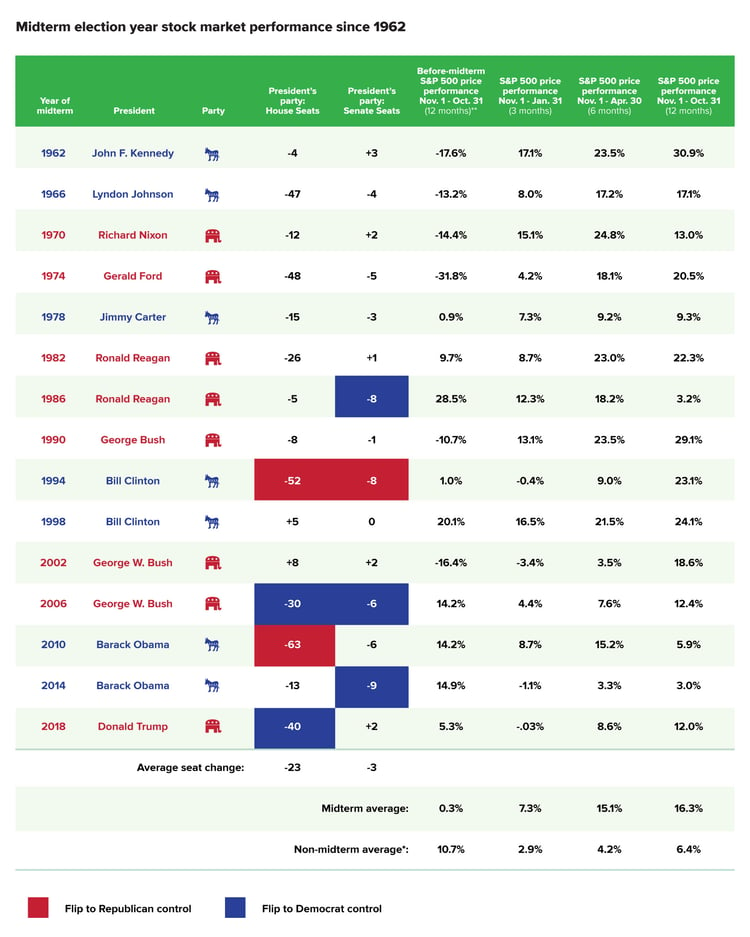Are you worried about how the upcoming midterm election will impact your investment portfolio? This concern may compel you to change your portfolio based on the polls leading up to the election. You’re not alone.
We understand this worry. But we don’t subscribe to the common belief that politics and investing are intimately connected. Here are three reasons we believe why.
First, the market tends to go up regardless of election results
We hear many questions regarding elections and the market.
The most common is: How does the market react to a midterm election? The market’s reaction to an election may differ in the short term than in the long term. For example, in the first three months following all the midterm elections since 1962, the market fell approximately one-quarter of the time. In three out of the four instances—2002, 2014, and 2018—control flipped to the other party in either the Senate, House of Representatives, or both.
But by six and twelve months after every midterm election since 1962, the market was positive, regardless of who won Congressional seats.

Source: USbank, Jun. 22, 2022. Data source: Bloomberg from Oct. 31, 1961 through Dec. 31, 2021. *The average monthly price return for the S&P 500 in three-, six-, and 12-month increments, starting in the month of November of every year since 1963 where there wasn’t a midterm election held in that November. **The average 12-month price return of the S&P 500 in the 12 months preceding a midterm election, where the last date of the price close as of Oct. 31 is several days before the November midterm election.
Investors are also curious about the market’s reaction to Congressional control. In other words, how does the market perform when Congress is unified (a single party controls the Senate and House) vs. split (Senate and House are controlled by different parties)? Data show that in the past, the S&P 500 has risen over time regardless of Congress’ configuration. Since 1933, the average annual return with a unified Congress was 7.4% and with a split Congress was 10.8%.1
Is this time different? That’s always a question that no one can answer. There are specific and possibly unique challenges facing today’s economy. But economic hardships are not new. For example, the above chart shows that in the 12 months before the 2002 midterm, the market was down 16%—primarily the result of the dot-com bust. And in 1970 and 1974, the market was down 14% and 32%, respectively, on the heels of stagflation, an energy crisis, and a recession. In each of these three tough economic years, the market rose double-digits in the six and 12 months following those elections.2
Of course, no one (not even us!) can predict if that will happen after this election or how the market will respond, as past behavior is not a definite indication of future behavior. But the point is that even with a tough economic backdrop entering midterm elections, we take comfort in knowing that in the past, the market has delivered strong positive returns just a few months later.
Second, neither Congress nor the President controls the economy
While Americans are solely focused on electing politicians for Congress and local governments this midterm, the economy—for the most part—is in the hands of the Federal Reserve (the Fed).
The Fed is the U.S. central bank, a non-partisan, independent government body with perhaps the most decisive influence over spending, borrowing, and saving.
How does the Fed influence the economy? Primarily through monetary policy in the form of raising or lowering interest rates. It also can partially increase or decrease money in circulation to help slow or speed up economic activity.
Third, we believe that regulations and actions are more dominant than agendas.
Think of it like this: Agendas are the intentions of our elected officials; actions and regulations are what actually take place! In reality, many intentions never come to bear—because they get tied up or fall to the wayside.
Take how the federal government establishes fiscal policy—like taxes and aid or stimulus packages. The process works like this: Bills are proposed and approved by both the Senate and the House of Representatives and signed into law by the President.
Often, the passage of a bill requires some degree of bipartisanship—both parties working together. There are many bipartisan legislative examples littered throughout history. Examples go all the way back to the country’s origins with The Great Compromise in 1787 and, more recently, with the 2020 CARES Act.
Of course, there are examples of bills that were passed without the backing of both parties, too.
But to establish a rule of thumb that one should invest with the mindset that party agendas are a foregone conclusion to us seems rash. Not every agenda item results in regulations or other actions.
What may affect your money leading up to the election?
The market hates uncertainty. And around elections, political posturing—and, let’s face it, media stirring—can create market uncertainty. So once election winners are declared, uncertainty tends to wane, and we believe calm should resurface. This is good news! It means over the long term, in our opinion, your money should not be at the mercy of Washington politics.
What matters instead? We believe other market and economic factors—like inflation, economic growth, and interest rates—may impact investments more. But even then, we are long-term focused, so while we take these into account, we’re more attuned to selecting quality companies based on our expectations for their long-term competitiveness, economic prospects, and growth potential.

Like what you're reading?
Join the thousands of readers getting stories like this delivered straight to their inbox every Thursday — for free. Give it a spin, enter your email to sign up.
Footnotes
1 Source: Capital Group Strategas. As of December 31, 2021. Unified Congress indicates control of the House and Senate by the same political party, but control of the White House by a different party. Split Congress indicates control of the House and Senate by different parties, regardless of White House control. Data for the S&P500 Index from 1933 through 2021.
2usbank, Jun. 22, 2022
Related Articles

How Has the Stock Market Performed During Recessions? You Might Be Surprised
A recession is loosely defined as a decline in economic activity and employment. There isn’t one...

How to Achieve Your Wealth Goals While Being a Caregiver
Do you fantasize about the day you stay indefinitely at your grown children's home, drop all of...

End of Life Planning: Ease the Burden on Your Loved Ones
Most of us avoid the topic of death, especially around our older family members. But end-of-life...
.jpg)